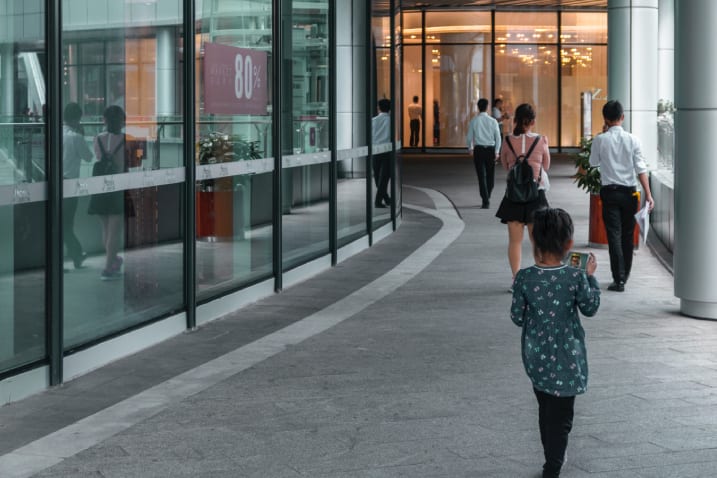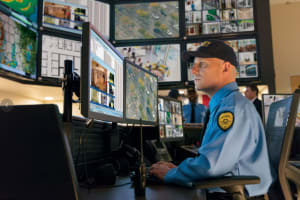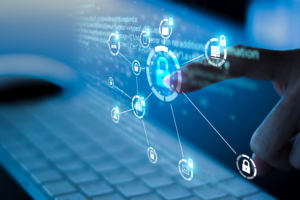How to Prevent Unauthorized Physical Access in the Workplace

As organizations become increasingly reliant on technology to safeguard their facilities and protect their people and assets, it's critical to ensure that physical security measures are consistently in place. Unauthorized physical access can pose a significant threat to the safety and security of employees, sensitive data, and valuable property. In order to help your organization strengthen physical security efforts, we'll define what unauthorized physical access is, discuss the risks associated with it, and provide best practices for preventing unauthorized access. We'll also explore how LenelS2’s solutions can help organizations secure their premises and protect against physical security breaches.
Key Takeaways
- What Unauthorized Access Means: Unauthorized physical access occurs when individuals gain entry to restricted areas without proper credentials, often bypassing security measures like keycards, biometrics, or PIN codes.
- Prevention Strategies: Effective methods for preventing unauthorized access include implementing strong passwords, two-factor authentication, regular software updates, encryption, and robust monitoring practices.
- Common Causes of Breaches: Physical security breaches are often caused by human error, internal threats from employees, outdated security systems, and lost or stolen credentials.
- Physical Security Countermeasures: To prevent unauthorized access, organizations should use physical security measures such as access control systems, surveillance cameras, barriers, and security guards, along with intrusion detection systems.
- Hybrid Work Environments: As hybrid work models increase, it’s essential to manage and monitor access both onsite and remotely, ensuring security systems are integrated to protect sensitive data across multiple locations.
- LenelS2 Solutions: LenelS2 offers a range of customizable solutions to manage physical security, including cloud-based access control, biometric authentication, and video surveillance.
What is Unauthorized Access?
Unauthorized physical access refers to a person gaining entry to a secured area or perimeter without the proper credentials or authorization. This can happen when an individual gains access to a restricted area by bypassing security measures such as physical or mobile credentials, keypad codes, or biometric authentication.
Traditionally, physical access control privileges are dictated by two key factors, location and time - what areas in a facility an individual has access to and at what days and times they are able to access these areas. These privileges are then validated when an individual presents a credential at an authentication device, such as a reader, for validation of their identity and access to the area. There are many facets to physical access control, and with the many facets opportunities for unauthorized physical access.
The consequences of unauthorized physical access can be severe, including theft, damage to brand image, and compromise of sensitive data. In order to prevent unauthorized access, organizations need to implement effective physical security measures that limit access to authorized personnel only.
What Causes Physical Security Breaches?
One of the primary functions of physical security is to limit what individuals have access to and within a facility. Unauthorized physical access can take many different forms and can be caused by a variety of factors, including:
Human Error
The weakest link in any security system is often the human factor. Mistakes in assigning privileges or not properly removing individuals from the system when they leave an organization can result in unauthorized access. Note that LenelS2 offers the ability to automate this process through integration with business systems such as IT directory services, human resource systems, or identity management systems. Additionally, artificial intelligence and machine learning can identify abnormalities in security privileges and automatically adjust them or flag them so administrators can make the appropriate decision about granting or removing an individual’s access.
Employee Threats
One of the highest risks of physical security breaches is internal threats from employees. This is why it's important to follow a policy of role-based access control (RBAC) to assign access based on employee roles and responsibilities within the organization. By limiting access to sensitive areas to a limited number of people, organizations can reduce the risk of theft and other security breaches.
Additionally, terminated or recently departed employees also are a risk to any facility's security. It is important that an organization has a defined process for offboarding employees after they leave the organization, and this process should include the retrieval of their physical credentials, as well as removing their access privileges for all security and IT systems.
Cybersecurity & Outdated Systems
Many organizations are concerned with the investment and effort deploying a new security management system would require. On the other hand, outdated systems can pose a significant risk as well. Many older security management systems are not following the latest industry best practices and can be an attack vector for potential cyber or physical intrusion. Older security management systems will not have the same level of encryption, system hardening, or utilization of modern technologies as new security management systems do. Additionally, many leverage dated peripheral devices, such as older readers, cameras, or access control panels, as well as older infrastructure which are all attack vectors for potential cyber-attacks. It's important for organizations to understand the current best practices as it relates to cybersecurity and examine their existing systems to see if they meet these standards.
Credentials & Lost Badges
One of the common causes of physical security breaches is lost or stolen credentials. This can occur if an individual loses a physical card or if someone gains unauthorized access to another individual's credentials by copying or cloning their card. A lost or stolen credential in the hands of a bad actor will allow that individual the ability to utilize that credential to gain access to a facility as if they were the individual the credential was assigned to. When companies include their logo or location on the credential, organizations can face additional risk. For example, if an employee drops a badge in downtown Manhattan, it’s easy for a bad actor to identify the building’s location and bypass an access control system.
Even with the event of cloud-based access control, physical security still requires on-premise hardware such as card readers, panels, locks, cables, and cameras to ensure a secured facility. It's important for organizations to stay vigilant and ensure that all aspects of their physical security infrastructure are up-to-date and functioning properly.
Supply Chain
Security professionals are often concerned about supply chain shortages and how they may impact their ability to keep their facilities safe and secure. LenelS2 mitigates these concerns by being creative and trying to use available substitutes for products that may be in short supply. It is best practice to maintain a stock of any critical components that may be needed to ensure a 100% uptime on the security perimeter. This may include stocking access control panels, readers, and other security ancillary devices.
Tailgating or Social Engineering
One common method of gaining unauthorized access is through tailgating or social engineering. A common example of tailgating can occur when someone holds the door open for someone else, allowing them to gain access to a secure area. The individual who gains access through tailgating has not been authorized or authenticated and may be using social engineering of social norms or common courtesy to access a facility. By training employees on the importance of access controls and the risks associated with tailgating, organizations can reduce the risk of these types of security breaches.
What Are the Physical Security Countermeasures Designed to Prevent Unauthorized Access?
Physical security countermeasures are measures put in place to protect a building, its contents, and its personnel from unauthorized access. These countermeasures help safeguard sensitive areas by ensuring that only authorized individuals are allowed to enter certain premises. The most common physical security countermeasures include access control systems, surveillance cameras and video analytics, barriers and physical locking mechanisms, security guards and patrols, and intrusion detection systems (IDS). Let’s take a closer look below.
- Access Control Systems: These systems manage and monitor who can enter specific areas of a facility, based on time, location, and security clearance. Access control systems can use a combination of physical cards, biometric verification, and mobile credentials to grant or deny access.
- Surveillance Cameras and Video Analytics: Video surveillance helps to monitor areas in real time and provides recorded evidence in case of a security breach. With modern systems, AI-based video analytics can also help detect unusual behavior and provide proactive alerts.
- Barriers and Physical Locking Mechanisms: Physical barriers, such as fences, walls, gates, and locked doors, help prevent unauthorized individuals from accessing secure areas. These can be enhanced with anti-tailgating systems that prevent multiple people from entering using a single credential.
- Security Guards and Patrols: In many facilities, physical security personnel are employed to oversee access points and monitor the premises. Security guards are often stationed at entryways and critical areas to verify credentials and respond to suspicious activity.
- Intrusion Detection Systems (IDS): These systems detect unauthorized access attempts through alarms or sensors that trigger when a door or window is tampered with. IDS can be integrated with access control and video surveillance systems for a unified response.
These countermeasures, when combined, provide a robust security framework that limits the possibility of unauthorized access and protects valuable assets.
What are the Risks of Physical Security Breaches?
Physical security breaches can have significant consequences for an organization. While petty theft and vandalism are common risks, there are more critical threats that organizations should be aware of.
Cyber Threats and Data Security
Cybersecurity threats are a major concern for organizations, particularly when it comes to data security. This can include training employees on best practices for cybersecurity and implementing a strong access control system.
Compliance with Regulations
For organizations in many industries, compliance with government-mandated regulations is business critical. This can apply to multiple different industries, including financial, critical infrastructure and utilities, and healthcare, and each have their own set of standards and regulations. For example, in the healthcare industry, ensuring your security practices are following the requirements of HIPAA is critical. This means securing access to private patient records and drugs/narcotics within the facility. By securing doors and medicine cabinets with access controls, organizations can ensure that only authorized individuals can access these sensitive areas. Keeping in compliance with government-mandated regulations is important due to the financial penalties that can occur to an organization if an event occurs or is at some point deemed to have fallen out of compliance.
Stealing Data
Data theft is another risk associated with physical security breaches. When bad actors are able to gain access to a facility, it’s easier to access a company’s IT systems and network infrastructure to access valuable proprietary information. This breach can open the potential for exposure in media or news outlets, giving companies bad press. By implementing strong access controls and monitoring for abnormal behavior, organizations can reduce the risk of data theft.
Stealing Valuable Assets
For organizations with valuable assets, such as banks or museums, the risk of theft is always present. By using access controls and surveillance, organizations can monitor for unauthorized access and quickly respond to potential security breaches.
10 Best Practices for Preventing Unauthorized Physical Access
As seen above, unauthorized access can open many issues for organizations. But there are steps that can be taken to mitigate this threat. To prevent unauthorized physical access, we recommend implementing the following best practices:
1. Leverage Mobile Credentials or Biometric Data
Consider using mobile credentials or biometric data for authentication instead of physical plastic badges. Biometric credentials are ideal for government, data centers, and areas with higher levels of security within a facility. Mobile credentials can be less expensive and more versatile, and they can be distributed and utilized quickly and easily. They can also be granted for a specific timeframe and disbursed easily by the security team. Since smartphones have an extra layer of security to them, a lost device does not pose the same security threat for an organization as a lost badge. For workers that may be hybrid or for issuance to temporary workers or contractors, mobile credentials can be a great way to provide a security credential without having to physically hand a person a card.
2. Audit the Cybersecurity of Your Security Management System
3. Use AI to Monitor Threats
Anomaly Detection:
Use AI and machine learning for anomaly detection such as a card being used outside of regular business hours.
Predictive Analytics:
Use predictive analytics to monitor and identify potential security risks regarding hardware failure.
Tailgating:
AI can also monitor tailgating to identify if the number of people entering a door matches the number of badges swiped.
Compliance:
LenelS2 offers AI software that checks for compliance and can notify security administrators to change or remove access if needed. This AI tool will cross reference a company’s internal directory to determine who should have access based on role and job function. For example: If an employee is granted IT permissions, but works in marketing, AI could detect that and flag it.
4. Automate as Much as Possible
Automate the onboarding and offboarding of employees and their access to minimize human involvement. This ensures that access privileges are assigned and removed promptly and accurately without human involvement. Automation can be easily implemented by integrating your security management system with a business system such as an HR system, IT directory services, or an identity management system. Additionally, LenelS2 has a feature described as ‘use it or lose it’. If a card remains unused for a certain number of days, it automatically disables. It’s a safeguard put in place for situations where a building might have a contractor or temporary worker that forgets to return their card, or an individual loses a card and does not report it.
5. Role-Based Access Control
6. Facilitate Communications Between Teams
7. Use Video Analytics and Surveillance
8. Regularly Review Data to Ensure Compliance
9. Education
10. Non-Descript Badges
Best Security Practices for Hybrid Work Environments
Each environment comes with its own unique challenges, with the last tips being suited for in-person locations. As many organizations adopt a hybrid work model, it's important to also consider the security implications of employees working both on and offsite. Here are some best practices for maintaining security in a hybrid work environment:
Pre-register When Employees Will Work in the Facility
To ensure that employees have the necessary access to facilities when they are onsite, it's important to pre-register them ahead of time. This can be done using a portal or other system that allows employees to request access to specific facilities or areas. By pre-registering employees, you can ensure that they have the necessary access when they arrive and minimize delays or disruptions.
Coordinate Access Accordingly
In a hybrid work environment, employees may be working from different locations or traveling to different facilities more often than before. It's important to coordinate access accordingly so that employees can gain access to the sites they need to work. This can be done using an access control system that allows you to manage access rights for different individuals across multiple locations all appearing in a single system.
Integration of Physical and Logical Security
To prevent remote data breaches and ensure that employees are working from secure locations, organizations can require employees to scan their access cards onsite before logging into computers or systems located at that physical site. This can help to ensure that employees are physically present in the location where they should be working and prevent unauthorized access to data.
Training
Add badge procedures and guidelines into employee onboarding training. Even if they do not come into the office, it is important for employees to understand what they do have access to and what they do not have access to. Especially in cases where the employee might not come into the office often, it is important to outline what level of authorization they have and policies involving guests
How LenelS2 Can Help Prevent Unauthorized Physical Access
Alongside our various tips and advice, LenelS2 offers a variety of physical security solutions that can be tailored to meet the needs of different organizations. Our access control systems use credentials like physical badges, mobile credentials, and biometric data to authenticate users and manage who can enter their facilities at what times. Video surveillance solutions use advanced analytics to identify anomalies and alert security personnel, while cloud-based systems provide increased flexibility and scalability.
LenelS2's products can be integrated with third-party systems like HR databases, IT directory services, and video management systems to allow for easy onboarding and offboarding of employees, automatic updates of access privileges, and seamless management of physical security across multiple platforms. We also offer training programs and support to ensure that our clients can effectively use their products and services.
Finally, our "use it or lose it" feature helps keep security systems up-to-date by automatically disabling access cards that haven't been used within a certain amount of time. This ensures that only active employees have access to the facility and reduces the risk of unauthorized access.
Learn more about how LenelS2’s products can help your organization prevent unauthorized physical access by requesting a free demo today. Additionally, our security system support ensures that your systems remain efficient and compliant with the latest security standards




